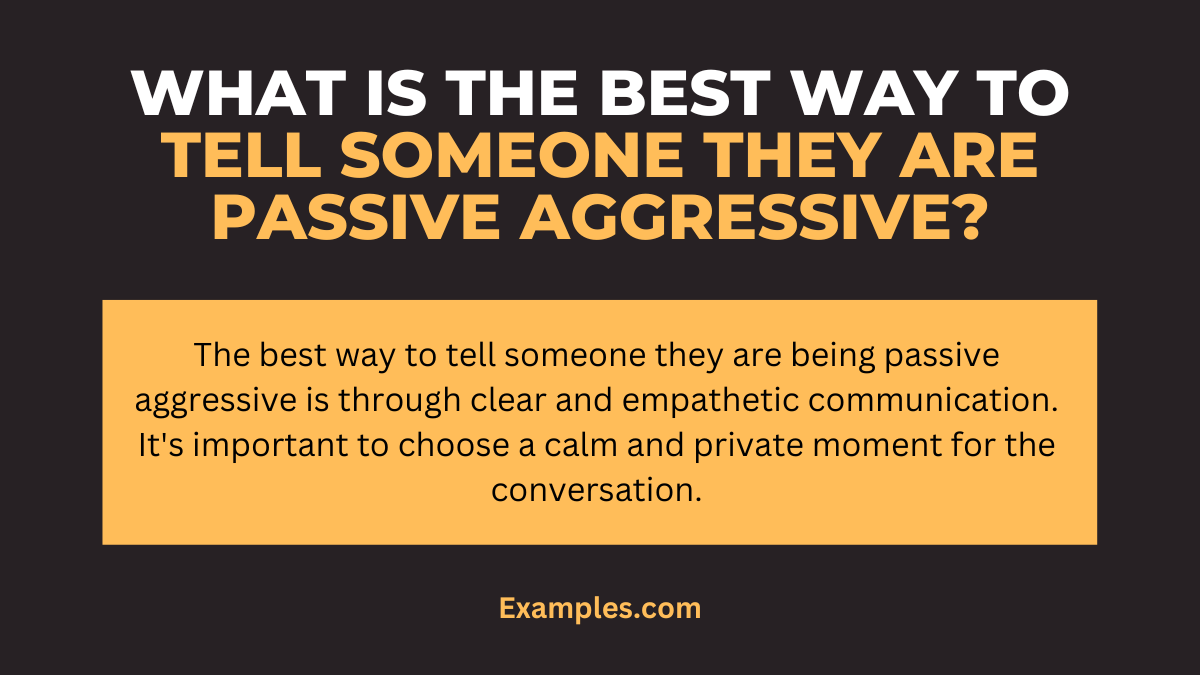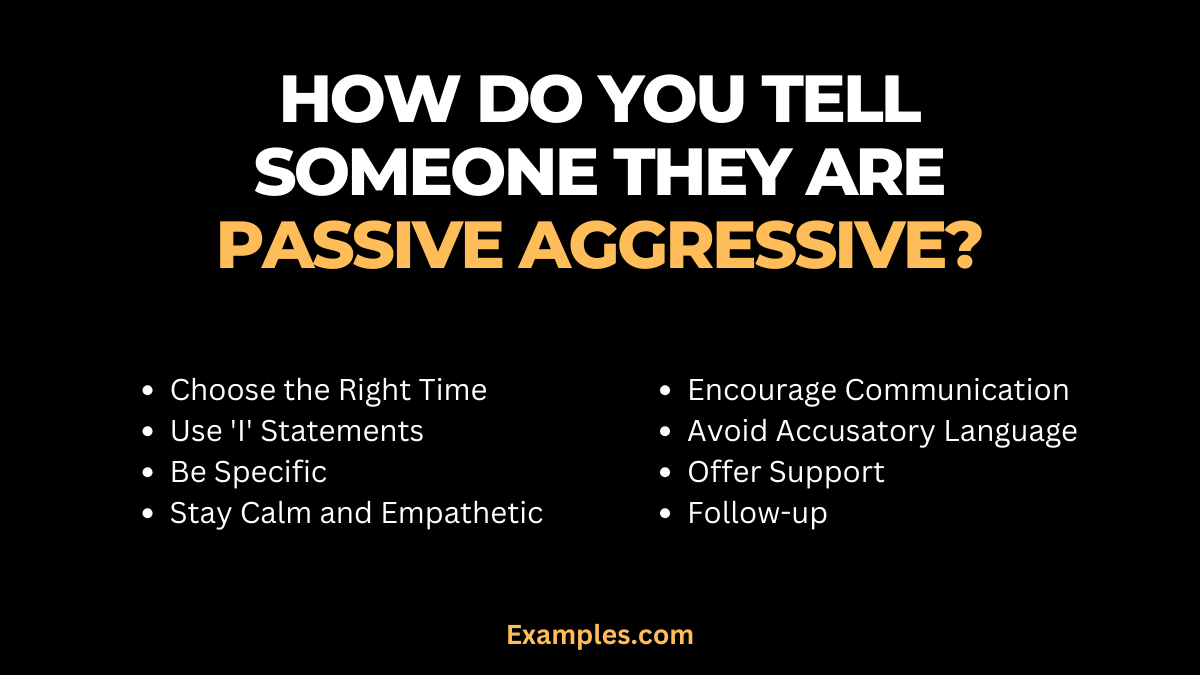How Do You Tell Someone They Are Passive Aggressive?
Understanding of addressing passive-aggressive behavior in various contexts. It offers real-life communication examples and practical strategies to approach this delicate topic. The guide is designed to assist readers in identifying passive-aggressive traits, and articulating their observations in a constructive, non-confrontational manner. It emphasizes the importance of empathy and clarity in such conversations, aiming to foster better understanding and improve interpersonal relationships. This guide is essential for anyone seeking effective ways to navigate the complexities of passive-aggressive communication.
What is the Best Way to Tell Someone They Are Passive Aggressive?

The best way to tell someone they are being passive aggressive is through clear and empathetic communication. It’s important to choose a calm and private moment for the conversation. Using ‘I’ statements can help in expressing how their behavior affects you without sounding accusatory. Be specific about their actions and explain the impact these actions have. Offering support and understanding, and encouraging more open communication can make the conversation productive and less confrontational.
How Do You Tell Someone They Are Passive Aggressive?

Addressing someone’s passive-aggressive behavior can be challenging but necessary for healthier communication. Here’s an expanded view on how to approach this conversation:
- Choose the Right Time and Setting: Select a private and comfortable setting for the discussion. A neutral environment can help the person feel less defensive and more open to the conversation. Ensure there are no distractions and both of you are in a calm state of mind.
- Use ‘I’ Statements: Begin sentences with ‘I’ to express your feelings and how their behavior impacts you. This approach focuses on your perspective and reactions, rather than placing blame on the other person. For example, “I feel overlooked when my suggestions are dismissed without discussion.”
- Be Specific: Offer clear, concrete examples of their passive-aggressive behavior. This specificity helps them understand exactly what actions or words are problematic. For instance, “I noticed that you agreed to the deadline in our meeting, but the work was submitted late without any communication.”
- Stay Calm and Empathetic: Approach the conversation with a calm demeanor. Showing empathy acknowledges that their behavior may be a defensive mechanism and helps create a non-threatening atmosphere. Communicate that you understand that change is challenging.
- Encourage Open Communication: Suggest more direct and open ways of communicating. Express your willingness to listen and be receptive to their thoughts and feelings. For example, “If there’s something bothering you about this project, I’m here to discuss it openly.”
- Avoid Accusatory Language: Frame the conversation positively, focusing on improving communication rather than casting blame. This might involve saying, “I think we can work better together with more direct communication.”
- Offer Support: Reassure them of your support in their efforts to communicate more directly. Let them know that you’re there to help and not to judge. For example, “If you’re finding it difficult to express something directly, I’m here to help you through it.”
- Follow-up: Keep the lines of communication open. Recognize and positively reinforce improvements in their communication. A follow-up conversation can also provide an opportunity to discuss any ongoing challenges.
By adopting these strategies, you can effectively address passive-aggressive behavior, leading to improved understanding and stronger communication in your relationship or workplace.
Examples for How Do You Tell Someone They Are Passive Aggressive
Telling someone they are passive-aggressive requires tact and sensitivity. It’s important to approach the conversation with empathy, focusing on specific behaviors rather than labeling the person. Effective communication involves expressing how their behavior impacts you and the environment, and suggesting more constructive ways to communicate. It’s crucial to remain respectful and avoid accusations, as the goal is to improve communication, not to criticize or confront.
- “When you say things are fine but act upset, it’s confusing. Can we talk openly?” – Addresses the discrepancy between words and actions.
- “I’ve noticed you often agree but seem unhappy later. Let’s discuss any concerns directly.” – Points out inconsistency in agreement and later behavior.
- “Your sarcasm makes it hard to understand your true feelings. Can we be more direct?” – Addresses the use of sarcasm and the need for clarity.
- “When you don’t express what’s bothering you, it’s difficult to resolve issues. Let’s try to communicate openly.” – Encourages open expression of issues.
- “I feel there’s something unsaid when you give short replies. Is there more you’d like to share?” – Invites more in-depth communication.
- “It seems like there might be underlying issues when tasks are delayed. Can we address this?” – Connects task delays with possible unspoken issues.
- “Your jokes sometimes seem to hide real concerns. It’s okay to speak openly here.” – Recognizes hidden concerns behind humor.
- “I’ve noticed some tension. Is there something we need to talk about?” – Acknowledges sensed tension and invites discussion.
- “When you withdraw, it’s hard to understand your viewpoint. Can we discuss this?” – Addresses withdrawal as a communication barrier.
- “Your emails can be hard to interpret. Let’s clarify to avoid misunderstandings.” – Discusses the need for clarity in written communication.
How To Call Someone Out for Being Passive Aggressive?
Calling someone out for passive-aggressive behavior involves direct yet respectful communication:
- Identify Specific Incidents: Citing exact instances provides clear examples of the behavior in question, making it easier to discuss objectively.
- Express Your Feelings Clearly: Articulate the impact of their behavior on you, using ‘I’ statements to convey your feelings without placing blame.
- Encourage Directness: Promote open communication by encouraging them to share their thoughts and feelings directly, thus fostering a more honest dialogue.
- Maintain a Respectful Tone: A respectful, calm tone is crucial to prevent defensiveness and keep the conversation constructive.
- Avoid Public Call-Outs: Discussing the issue privately helps avoid public embarrassment and defensive reactions.
- Seek Mutual Understanding: Aim to reach an agreement on better ways to communicate moving forward, highlighting the benefits of direct and open interactions.
- Consider Mediation: If direct discussions don’t lead to change, involving a neutral third party can provide a fresh perspective and mediate the conversation.
Calling out passive-aggressive behavior should aim to improve communication and understanding, not just to highlight a problem.
Examples for How Do You Call Someone Out for Being Passive Aggressive
Calling someone out for being passive aggressive should be done thoughtfully and constructively. It’s crucial to address the behavior respectfully and directly, focusing on specific instances rather than general personality traits. Communicating in a calm and non-confrontational manner is key. The aim is to open up a dialogue for more transparent and effective communication, not to provoke or blame. Using ‘I’ statements and expressing your own feelings about the behavior can facilitate a more understanding and productive conversation.
- “When you say things are okay but act upset, it’s confusing. Let’s talk about what’s really going on.” – Addresses discrepancies between words and actions.
- “I feel undermined when you make sarcastic comments about my ideas. Can we discuss this?” – Expresses personal feelings about specific behavior.
- “I noticed you agreed to the deadline but didn’t meet it. Is there a reason?” – Directly addresses a specific passive-aggressive action.
- “Your emails often seem indirect. Can we clarify your points for better communication?” – Requests clarity in communication.
- “I sense some reluctance in your agreement. Do you have any reservations?” – Addresses non-verbal cues of passive-aggression.
Tips for Effective Communication to Tell Someone They are Passive Aggressive
Effectively communicating with someone about their passive-aggressive behavior requires a delicate and understanding approach:
- Prioritize Empathy: Approach the conversation with empathy, showing that you understand their behavior might be a coping mechanism.
- Frame Concerns Constructively: Discuss your concerns in a way that focuses on the impact of their behavior and how it can be improved.
- Use Non-Accusatory Language: Frame your language to avoid sounding accusatory, which can escalate the situation.
- Highlight the Positive: Mention their strengths or positive aspects of their communication to balance the feedback.
- Listen Actively: Be prepared to listen to their side of the story without interrupting or dismissing their feelings.
- Offer Guidance: Suggest ways they can communicate their needs or concerns more directly.
- Avoid Public Discussions: Have the conversation in private to prevent embarrassment or defensiveness.
- Stay Solution-Focused: Keep the discussion focused on finding solutions and improving communication.
- Follow-Up: Check in after the conversation to address any ongoing issues or improvements.
- Seek Mutual Understanding: Aim for a mutual agreement on how to communicate effectively moving forward.
By following these tips, you can address someone’s passive-aggressive behavior in a way that is respectful and conducive to positive change.
In concluding the article on identifying passive-aggressive behavior, it’s crucial to approach conversations with empathy and respect. Telling someone they are passive-aggressive requires clear communication, emphasizing understanding rather than accusation. It’s about fostering a positive dialogue, encouraging open expression of feelings and needs. This approach not only aids in resolving underlying issues but also strengthens relationships through honest and respectful communication.



